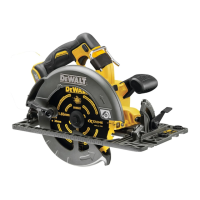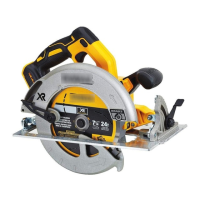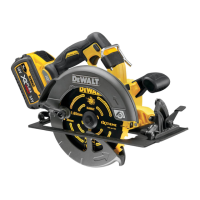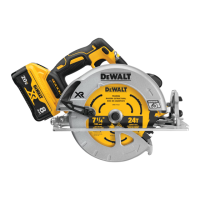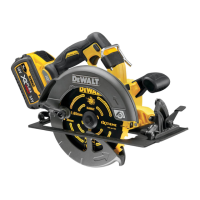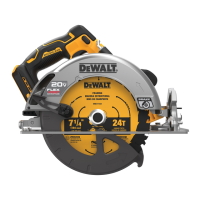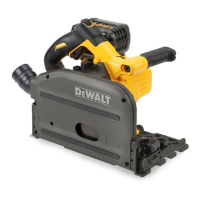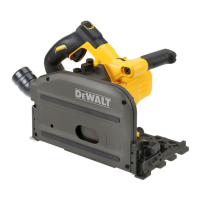22
ENGLISH
cutting parallel cuts and the other side of the rail is tuned in for
45° bevel cuts (Fig.R).
NOTE: If the anti-splinter guard is tuned in for parallel cutting
on both sides, then when the unit is bevelled, the blade will not
run true to the edge of the anti-splinter guard. This is because
the pivot point of the unit bevel is not stationary and the blade
moves out over when the unit isbevelled.
Kerf Indicator (Fig. S–U)
The front of the saw shoe has a kerf indicator
41
for vertical
and bevel cutting. This indicator enables you to guide the saw
along cutting lines penciled on the material being cut. The kerf
indicator lines up with the left (outer) side of the saw blade,
which makes the slot or “kerf” cut by the moving blade fall to
the right of the indicator. Guide along the penciled cutting line
so that the kerf falls into the waste or surplus material. Fig.T
shows the saw in the parallel cutting position relative to the
guide rail. Fig.U shows the saw in the bevel cutting position
relative to the guiderail.
Prior to Operation
• Make sure the guards have been mounted correctly. The
saw blade guard must be in closedposition.
• Make sure the saw blade rotates in the direction of the
arrow on theblade.
• Do not use excessively worn sawblades.
OPERATION
Instructions for Use
WARNING: Always observe the safety instructions and
applicableregulations.
WARNING: To reduce the risk of serious personal
injury, turn tool off and disconnect battery pack
before making any adjustments or removing/
installing attachments or accessories. An accidental
start-up can causeinjury.
Proper Hand Position (Fig. V)
WARNING: To reduce the risk of serious personal injury,
ALWAYS use proper hand position asshown.
WARNING: To reduce the risk of serious personal
injury, ALWAYS hold securely in anticipation of a
suddenreaction.
Proper hand position requires one hand on the main handle
3
,
with the other hand on the auxiliary handle
7
.
LED Worklight (Fig. A)
The LED worklight
10
is activated when the trigger switch is
depressed. When the trigger is released, the worklight will stay
illuminated for up to 20seconds.
NOTE: The worklight is for lighting the immediate work surface
and is not intended to be used as aflashlight.
Switching On and Off (Fig. A)
For safety reasons the trigger switch
1
of your tool is equipped
with a lock-off button
2
.
Press the lock-off button to unlock thetool.
To run the tool, press the trigger switch
1
. As soon as the
trigger switch is released, the lock-off switch is automatically
activated to prevent unintended starting of themachine.
NOTICE: Do not switch the tool ON or OFF when the saw
blade touches the workpiece or othermaterials.
Workpiece Support (Fig. W–Z)
WARNING: To reduce the risk of serious personal
injury, support the work properly and hold the saw
firmly to prevent loss ofcontrol.
Fig. W and Y show proper sawing position. Fig. X and Z show an
unsafe condition. Hands should be kept away fromcutting.
To avoid kickback, ALWAYS support board or panel NEAR the
cut, (Fig. W and Y). DON’T support board or panel away from the
cut (Fig.X,Z).
ALWAYS DISCONNECT BATTERY PACK BEFORE MAKING ANY
ADJUSTMENTS! Place the work with its “good” side—the one
on which appearance is most important—down. The saw cuts
upward, so any splintering will be on the work face that is up
when you sawit.
Cutting (Fig. Y)
WARNING: Never attempt to use this tool by resting it
upside down on a work surface and bringing the material
to the tool. Always securely clamp the workpiece and
bring the tool to the workpiece, securely holding the tool
with two hands as shown in Fig.Y.
Place the wider portion of the saw base plate on that part of the
work piece which is solidly supported, not on the section that
will fall off when the cut is made. As examples, Fig.Y illustrates
the RIGHT way to cut off the end of a board. Always clamp work.
Don’t try to hold short pieces by hand! Remember to support
cantilevered and overhanging material. Use caution when
sawing material frombelow.
Be sure saw is up to full speed before blade contacts material
to be cut. Starting saw with blade against material to be cut
or pushed forward into kerf can result in kickback. Push the
saw forward at a speed which allows the blade to cut without
laboring. Hardness and toughness can vary even in the same
piece of material, and knotty or damp sections can put a heavy
load on the saw. When this happens, push the saw more slowly,
but hard enough to keep working without much decrease
in speed. Forcing the saw can cause rough cuts, inaccuracy,
kickback, and over-heating of the motor. Should your cut begin
to go off the line, don’t try to force it back on. Release the switch
and allow blade to come to a complete stop. Then you can
withdraw the saw, sight anew, and start a new cut slightly inside
the wrong one. In any event, withdraw the saw if you must shift
the cut. Forcing a correction inside the cut can stall the saw and
lead tokickback.
IF SAW STALLS, RELEASE THE TRIGGER AND BACK THE SAW
UNTIL IT IS LOOSE. BE SURE BLADE IS STRAIGHT IN THE CUT AND
CLEAR OF THE CUTTING EDGE BEFORERESTARTING.
As you finish a cut, release the trigger and allow the blade to
stop before lifting the saw from the work. As you lift the saw,
the spring-tensioned telescoping guard will automatically close
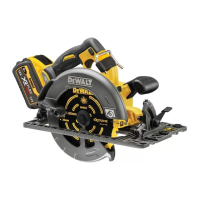
